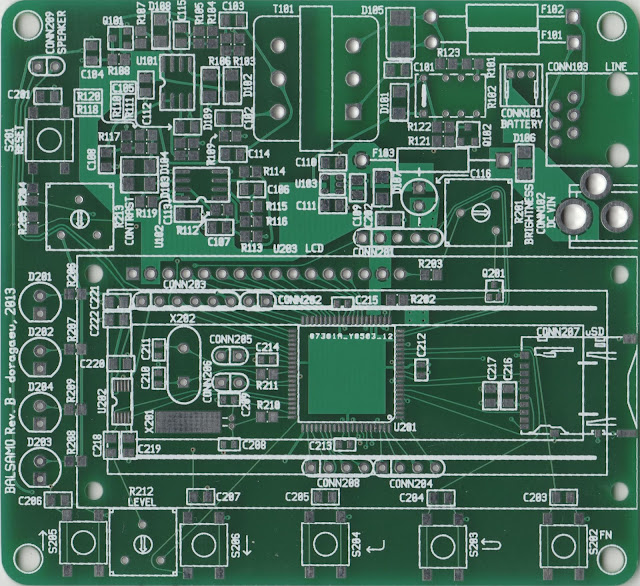The heart of the system is the same: a dsPIC30F6014, a 2x16 LCD, some analog chips (amplifiers and a linear regulator) and some more discrete components. The RS-232 serial port connector and the level transtator have been removed (I used them only for debugging), but a lot more things have been added. Balsamo's features are:
- Caller ID (CID) decoding. Decoding is done entirely inside the dsPIC. No external CID decoder has been used.
- Capability to blacklist/whitelist calls, based on caller's number and on whether the caller number is private/hidden.
- Both blacklist/whitelist modes are supported. Also private/hidden calls can be configured to be allowed or blocked.
- FAT formatted microSD card support. The microSD card holds the configuration file (that includes the blacklist/whitelist), the RAW audio files played when a call is rejected, and the call log file.
- Now when a call is rejected, an audio message is played, to inform the caller about why the call has been rejected.
- Two different audio messages can be played to the caller: one for blocked numbers (blacklisted or not in the whitelist) and the other for blocked private/hidden calls.
- Logs to microSD card all the calls, and the action performed for each of them (ALLOW/BLOCK).
- Clock function. The user has only to set the year. All the other date/time parameters are automatically set each time a call is received (they are extracted from the CID data).
- Simple user interface with a 2x16 LCD, 4 LEDs and 5 pushbuttons (only 4 of them are used so far: up, down, enter, esc). The user interface is complete and easy to use: you can add/remove numbers to the blacklist/whitelist, enable/disable the call filter, browse the list, browse recent calls, add recent calling numbers to the list, etc.
- Low power design: the system drains 4.4 mA while idle (most of the time, while waiting for a call) and around 20 mA when active. The design is entirely 3.3 V, but uses a low drop-out input regulator to be able to use a wide input voltage range.
- Backup battery capability: the PCB allows for a battery to be used along with a wall AC adapter. If there is a power fail, the backup battery allows the system to continue working until power is restored.
The new PCB has been designed using the GPL licensed gEDA suite. Schematics have been drawn with gschem and PCB has been routed with PCB. This is the first time I seriously use PCB, and the learning curve is really steep, but I'm pretty pleased with the results. I also tested KiCad and Eagle (warning, the last one is not free), but I find PCB more professional (and also harder to learn). I have used its experimental (and buggy) toporouter and I really like the way it draws tracks, in any angle, with curved corners and minimizing track length. Too bad it needs a lot of polish. For the track to pin connections, I have used the Teardrops plugin by DJ Delorie.
You will not find any digital chips in the design, other than the dsPIC and the LCD. The dsPIC does almost all the work, there is no external ADC, DAC, SD/FAT controller, CID decoder, etc. Only a dsPIC, some analog chips and discrete parts. FSK signal is sampled using the internal 12-bit ADC inside the dsPIC, and audio messages are played using a 32 kHz PWM signal. SD card FAT filesystem is handled by the impressive FatFs by Elm Chan software implementation.
Another addition to the Rev.B PCB is an audio amplifier. It can drive a small speaker. The amplifier has been tested and works, but it is still unused. It might be used in the future to play acoustic notifications when a call is blocked, and to implement answering machine capabilities (to play recorded messages). There are also plenty pins available to hack and extend the board functionality, including two UARTs, an SPI bus and an I2C bus, but I don't think I'll need them in the future.
Now this is where a video of the gadget working would be nice. Unfortunately I don't want to mess right now with video editing for removing real telephone numbers and that kind of stuff, so we will have to forget about it (at least until I get the time and motivation).
You can find a lot more information about this project, along with the source code, design files (schematics and PCB), GERBER files, etc. on my Balsamo GitHub repository. Everything is GPLv3+ licensed, so feel free to grab and modify it as you wish.
Happy hacking!

